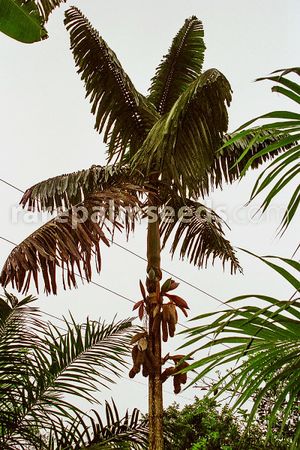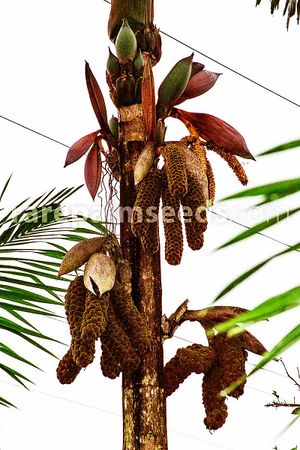Wettinia quinaria
| Wettinia (weh-tin-EE-ah) quinaria (kwin-ahr-EE-ah) | |||||||
|---|---|---|---|---|---|---|---|
 Colombia. Photo by Dr. Rodrigo Bernal/Palmweb. | |||||||
| Scientific Classification | |||||||
| |||||||
| Synonyms | |||||||
|
| |||||||
| Native Continent | |||||||
|
| |||||||
| Morphology | |||||||
| |||||||
| Culture | |||||||
|
| |||||||
| Survivability index | |||||||
|
| |||||||
| Common names | |||||||
|
| |||||||
Contents
Habitat and Distribution
Wettinia quinaria is found in Western Colombia and Ecuador, in wet forest up to 1000 m elevation. Often dominant in areas with more than 4000 mm of precipiation.Description
Canopy palm. Stem solitary, 8-15 m tall and 10-20 cm in diameter, smooth. Leaves 3-5.5 m long; pinnae 35-60 on each side, entire, pendulous, sparsely pubescent below, the central ones 60-115 cm long and 4-12 cm wide, with 16-18 prominent veins. Inflorescences 5-7 per node; peduncle 10-40 cm long; rachis 1-8 cm long; branches 4-7, to 40 cm long. Male flowers about 8 mm long, with 8-11 stamens. Female flowers densely crowded along the branches, to 20 mm long. Fruits green, with sparse white pubescence, ca. 2-3.5 cm long and 1.5-2.5 cm in diameter, forming 4-7 sausage-like clusters. (Borchsenius, F. 1998) Editing by edric.
A solitary, tall, moderately slow growing, monoecious, crownshaft palm. Common in cultivation, locally common in the wild. It has a smooth, light-grey trunk, 15 m. (49 ft.) tall, 20 cm. (8 inch) diameter with no obvious leaf scars, and huge segmented, pinnate (feather) leaves, 3 m. (10 ft.) long, 0.6 m. (2 ft.) wide, dark green above and beneath. (Treebrown.com)
Culture
Wettinia quinaria can survive freezing temperatures to about -3.8°C (25°F), but freezing is best avoided. It naturally occurs in wet rainforest or seasonally wet forest in montane locations. In this type of natural environment temperature fluctuations are slight, and this palm prefers a constantly cool or mild climate with little temperature difference between day & night, and Summer & Winter. Under extreme freezing conditions we recommend you keep this palm as dry as possible, and well wrapped up. (Treebrown.com)
Comments and Curiosities
Uses:Leaves used for thatch. Trunks used for house construction. Fruits edible. Edible larvae collected from decomposing stems. Coaiqueres. Trunks used for house construction.
Very abundant in lowland to premontane rain forest, from sea-level to 1000 m elevation. One of the most common palm trees of the Pacific coast.
"Attractive palm with long gray-green crownshaft and pendant, premorse (bitten-off tips) leaflets on long (up to 15'), straight leaves... gives the impression of looking at a skinny Holland windmill from afar (branches sort of form and 'X' shape from a distance). Has stilt roots in the wild, but not always seen in cultivation. Very tropical in its needs. from Panama, Colombia and Ecuador." (Geoff Stein)
South American palm from the cloud forests of the Andes grows to elevations of 1000m (3300ft), and is unbelievably beautiful when viewed in its wet and steep mountain habitat. In cultivation the seeds germinate quickly and subsequent growth is rather fast, producing a slender stem on short stilt roots and few leaves with large, dark green leaflets. It certainly benefits from humidity and can scarcely be overwatered if the drainage is good. A shady position in a mild tropical or subtropical climate completes the list of its requirements. (RPS.com)
- IMAGE GALLERY
External Links
References
Phonetic spelling of Latin names by edric.
Special thanks to Geoff Stein, (Palmbob) for his hundreds of photos.
Special thanks to palmweb.org, Dr. John Dransfield, Dr. Bill Baker & team, for their volumes of information and photos.
Glossary of Palm Terms; Based on the glossary in Dransfield, J., N.W. Uhl, C.B. Asmussen-Lange, W.J. Baker, M.M. Harley & C.E. Lewis. 2008. Genera Palmarum - Evolution and Classification of the Palms. Royal Botanic Gardens, Kew. All images copyright of the artists and photographers (see images for credits).
Many Special Thanks to Ed Vaile for his long hours of tireless editing and numerous contributions.




























